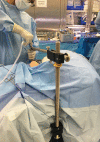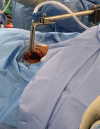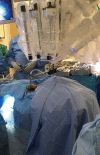Gasless trans-axillary robotic thyroidectomy: the technique and evidence
- PMID: 28713694
- PMCID: PMC5503928
- DOI: 10.21037/gs.2017.06.04
Gasless trans-axillary robotic thyroidectomy: the technique and evidence
Abstract
Robot assisted thyroid surgery has the advantage of a superior field vision and technical advancements of robotic technology that have permitted novel remote access thyroid surgical approaches. Gasless trans-axillary robot-assisted thyroidectomy has been proved to be among the most current feasible approaches. This approach offers an excellent cosmetic outcome, with comparable outcomes to conventional surgical approaches. This review aims to provide details of this specific remote access technique for thyroid resection with most recent evidences in the literature.
Keywords: Robotic-assisted; da Vinci; gasless trans-axillary; remote access; thyroidectomy.
Conflict of interest statement
Conflicts of Interest: The authors have no conflicts of interest to declare.
Figures








References
Publication types
LinkOut - more resources
Full Text Sources
Other Literature Sources
